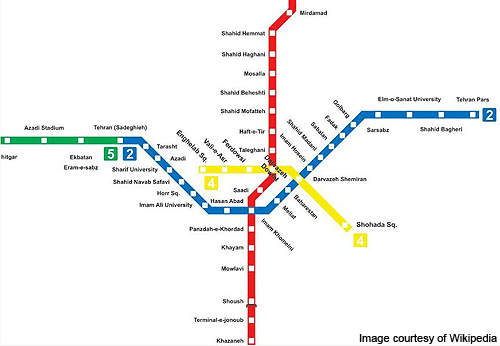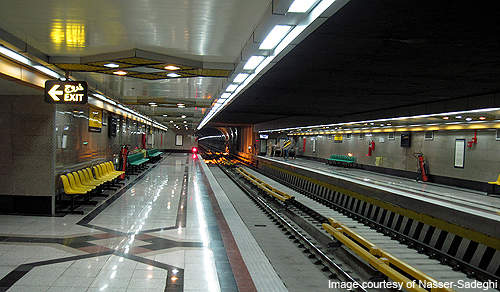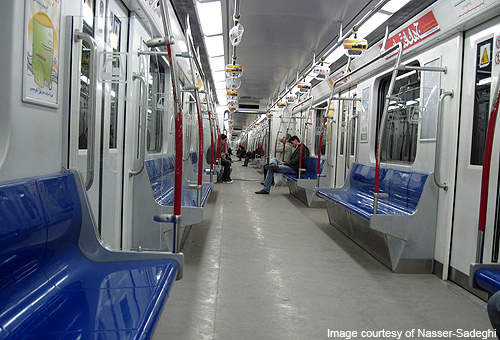Tehran Metro is a rapid transit system serving Tehran, the capital city of Iran. Four lines (lines 1, 2, 4 and 5) of the metro are operational while two lines (lines 3 and 7) are still under construction. The system is owned and operated by Tehran Urban and Suburban Railway.
Tehran’s is one of the busiest metros in the Middle East and the cleanest in the world. During the third quarter of 2010, an average of 4m passengers a day used the metro network. It is estimated that 6m passengers will use the metro daily once the new lines become operational. The number of passengers using the metro has grown from 3.5m in 1999 to 4m a day in 2010.
The metro network is currently 120km long. Upon completion of all the lines, the system will reach a length of 430km.
Background
Initial plans for the metro system were laid in late 1960s but could not be executed until 1982 due to socio-political issues such as the Iranian Revolution and the Iran-Iraq war.
In 1985, the city faced pressure from the growing urban population for a public transport system. It was then that a special purpose company Tehran Urban and Suburban Railway Company was formed to execute the initial plan.
The first line, Line 5, was opened on a priority basis in March 1999. It operated from Sadeghieh in Tehran to Karaj. Line 2 was opened in February 2000. It operated from Tehran Terminus at Sadeghieh to the centre of the city at Imam-Khomeini-Square.
Line 1 was opened in August 2001. It was initially a 10km long route between Ali Abad and Darvaze Dowlat in the north. It was further extended by 7km in the north to Mirdamad in March 2002, by 5km in the south to Shahr-e-Rey in October 2002 and by 6km to Haram-e-Motahar in March 2003.
Lines and routes
Line 1 (Red Line) is a 28km long route operating between Gheytariyeh in the north and Kahrizak in the south. It has 15 underground and seven elevated stations on this route. Shahid Sadr and Gheytariyeh are the new stations added to this line in 2010.
Line 2 is a 20km long route with 19 stations between Sadeghieh in the west and Farhangsara in the east. It intersects with Line 1 at Imam-Khomeini-Square. Farhangsara is the new station opened in 2010.
Line 3 will be a 36km long route starting from south-west in Islamshahr to Lashgarak in the north-east. It will have 23 underground and eight at-grade stations. It will pass through Chahardangeh, Rah-Ahan, Monirieh, Vali-e Asr squares, Shahid Beheshti Stree, Resalat, Majidieh streets and Imam Ali-Shahid Zeinuddin Intersection.
Construction on Line 3 commenced in mid 2007 and is still under way. It is being constructed in five phases and is scheduled for completion by 2014. The EPC contract is being executed by Lahmeyer International and its Iranian partner Moshanir for the first section.
Line 4 (Yellow Line) is 20km long with 21 underground and one elevated stations. The first 2.5km section from Darvazeh Shemiran to Ferdowsi Square opened in March 2007. It was further extended to Shohada Square and Engelab Square in 2009. Shahid Kolahdouz station is the latest to be added on this line in 2010.
Line 5 (Green Line) is a 41.5km long route starting from Sadeghieh at Tehran terminus and ending at Karaj Mahdasht Golshahr. It has seven stations and a terminal.
Infrastructure
Most of the metro is constructed underground to save above ground space for pedestrians and road transport. The tunnels have air-conditioning for 14 and 18 stations on Metro Lines 1 and 2 respectively. Natural lighting is provided in the tunnels through air ducts. Axial fans are used to lower the air temperature in the underground stations.
All the stations are constructed at an average distance of 1,100m from each other.
There are four maintenance terminals, the West Terminal, South Terminal, Tehran-Maehrshahr Terminal and East Terminal. Apart from the regular repairs and maintenance works, they are also used for parking and washing cars.
The system operates on third rail 750v DC power. A special power station at Bonyad-e-Rang transforms 230kV AC power into two 27.5kV AC for the trains on Line 5.
A new subway station is also being constructed at Sadeqieh. A deal has been signed with the Chinese Government to provide finance of up to €250m for the new station project.
Rolling stock
The entire metro runs on a standard gauge of 1,435mm. The trains have a top speed of 80km/h but are operated at 37km/h. Each of the metro trains has seven carriages with a passenger capacity of 1,290.
The Iranian Government plans to purchase 60 carriages and 28 locomotives to accommodate the increasing number of passengers.
Signalling and communication
The metro system uses a centralised traffic control system to control and manage the train traffic on all the lines.
In addition it uses supervisory control & data acquisition system (SCADA) to provide continuous energy and distribution of power on a priority basis.
The wayside system is used to determine the train position, distance and slope on the line, to control and direct trains on safety path.
The on-board ATP System is installed in the train control cabin. It includes a speedometer, a receiving antenna, a processing unit and data separation as part of a signalling and alarming system. The other telecommunications system included an optical and radio system, closed circuit television, a public message system and a central clock system.
Future
The government has spent around $80m in the second and third quarter of 2010 for further development of the metro system.
The future potential lines will be Lines 6, 7, 8 and 9.
Line 6 will be between Bokharaei in the southeast and Sadeghieh in the north-west. It is currently in the engineering phase.
Line 7 is under construction. It will begin in the north from Yousef Abad and end at Takhti Stadium in the south-east.
Lines 8 and 9 will encircle the outer suburbs. These are currently undergoing feasibility studies.






